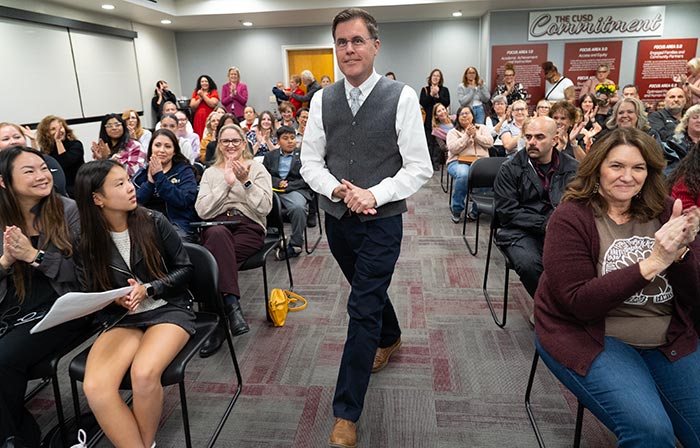Capital projects, real estate top list of 2015 CUSD news in 2015
Property sales and capital projects were among the biggest stories of the year for the Claremont Unified School District in 2015.
This October, escrow closed on the Claremont Unified School District’s old service center, located at 700 W. Baseline Road. The site, purchased at a May 2013 auction by homebuilder D.R. Horton, yielded the district $7 million.
In June of 2013, escrow closed on the sale of CUSD’s former district office, located at 2080 N. Mountain Ave. That property was purchased for $6.2 million in February 2012, also by D.R. Horton.
With its financial prospects looking rosier than they had in some time, the district felt it was expedient to explain to the community how the real estate proceeds have impacted the district.
“We want people to know that we’re using the property proceeds effectively,” Assistant Superintendent of Business Services Lisa Shoemaker said. “I think that sometimes, to you and I, $11 million feels like a lot of money. But it’s a drop in the bucket when it comes to the district’s facility needs.”
According to an October release, the district earned a total of $10,993,974 from the two parcels purchased by D.R. Horton. That number is comprised of the homebuilding company’s two bids minus expenses such as title and escrow fees and broker’s commissions.
It sounds like a pretty good chunk of change but, according to Assistant Superintendent of Business Services Lisa Shoemaker, CUSD has already used $7,700,603 of that money on some pressing needs.
These include a payment of $1.5 million CUSD committed towards Claremont High School’s Theatre Renovation Project. The money was used to buttress a $1.5 million matching Career Technical Education Grant from the state, helping to fund the $3 million Don P. Fruechte Theatre for the Performing Arts that opened in March 2014.
Surplus property sales funded construction of another building, the current service center located on the Richard Kirkendall Education Center site at 170 W. San Jose Ave. Completed in time for the 2014-2015 school year, it’s an 8,400-square-foot steel manufactured building with a customized interior and a $2,412,047 price tag.
Another much-needed building found its way onto the Sycamore Elementary School campus. For years, Sycamore’s multipurpose room has doubled as the school’s library. The district saw a way to provide the school with a real library when Baldwin Park Unified offered CUSD a free portable building in August of 2013.
Baldwin Park’s gift of the modular building, which is worth $250,000, was a boon. Still, there were considerable costs, $369,243 in total, associated with moving the structure, installing it, creating electrical and technological infrastructure and outfitting it as a library.
Another $1,830,822 of real estate proceeds was spent on a roofing project finished this summer at CHS.
The roofs at the high school tend to leak because most of the buildings have flat roofs—a norm at the time the campus was designed—where water can pool. In light of the unusual amount of rain predicted for this El Niño year, CUSD staffers and the board of education felt pressure to act quickly to stave off leakage.
A few structures like the music buildings were complete tear-offs, while others only required refurbishment. Drains were also installed on a number of the roofs.
Additionally, some $1,588,491 was spent on the logistical aspects of implementing the Common Core curriculum and its accompanying Smarter Balanced assessment. The money went to instructional tech, including the purchase of equipment and hardware such as iPads students will use to take standardized tests.
There is still some money from the property sales left in district coffers. The question is what CUSD will do with the remaining $3,293,371.
In June, the facilities department drew up a new, multi-million dollar list of vital projects, with those that concern health and safety—including Americans with Disability Act compliance—at the top.
Among the high-priority items is the modernization of the El Roble Intermediate School pool, which is currently drained and not functional. The Claremont High School pool is also in need of updating.
A study, at a cost of $45,000, is required before the district can determine the scope of the pool projects. For instance, CUSD would find out whether renovating one or both of the pools is likely to trigger ADA requirements with regards to the pool-adjacent locker rooms.
It’s complicated
The district was looking forward to reaping more real estate profits when, at a June 18 auction, Claremont Lincoln University (CLU) tendered the winning bid for the former La Puerta Intermediate School site.
CLU agreed to pay $14.35 million for the nearly 10-acre parcel located at 2475 N. Forbes Ave. It wasn’t long, however, before complications arose.
On July 23, the college held a community forum to gather input on its proposed use of the site. At the gathering, a representative of the architectural firm Swaback Partners assured attendees that the project would be low-density and low-impact. He also revealed that the university intended to flip La Puerta Sports Park, putting the college on Indian Hill Boulevard and moving the city sports fields to Forbes Avenue—a cost to be paid for by CLU.
Opponents objected to the geographic re-arrangement and worried that CLU would bring unwanted traffic and construction noise to the neighborhood. Others fretted that the proposed buildings would obstruct mountain views.
The community outcry likely played a part in Claremont Lincoln’s recent decision to rescind its offer, which was relayed to the district via email in mid-December.
“After conducting community engagement meetings with local residents, along with analyzing the needs and future growth of Claremont Lincoln University, the university decided not to pursue the purchase of the property,” Andrew Wilkin of Claremont Lincoln University wrote.
CLU asserts it will continue to look for an appropriate home in Claremont, and the district plans to bring the property to bid again in the near future. Still, the turnaround represents a significant financial blow to the district.
“I am disappointed in losing this deal,” Superintendent Jim Elsasser said. “We need the sale of the property to take those one-time revenues and put them into improving our facilities. We have tremendous facility needs in this district.”
It’s the second time that a La Puerta deal has fallen through amid community complaints.
The property was snapped up for $18.9 million at an auction in November 2013. The buyer, Irvine-based homebuilders Brandywine Homes, backed out of the deal a few months later when the city failed to approve the number of units the company had hoped to build on the site.
The twice-failed sale of La Puerta begs the question: What kind of project will garner community support?
From a sports court to solar array
Despite the dearth of funds for capital projects, Claremont did find a way to greenlight a couple significant facilities projects this year.
In October, San Antonio High School inaugurated its brand-new Lion Sports Court with a ribbon-cutting, followed by the school’s first volleyball game.
The outdoor sports court is 50 feet by 82 feet and features a sturdy plastic surface customized with SAHS’s green and black colors and emblazoned with the school’s leonine mascot. It’s a multi-purpose affair that can be also used for activities like basketball, tennis, badminton and roller or field hockey. The project took only about four days to complete, from demo to finish, and cost about $47,000.
The money came from an annual Recreational Assessment District (RAD) fee levied on Claremont property owners. The fee, which is $88.10 per single-family equivalent unit, is attached as part of local property taxes and yields the district some $1.2 million per year.
The idea behind the RAD, which has been in effect for more than 20 years in the City of Trees, is that property owners help pay to maintain school facilities that are open to the public.
“A lot of schools lock down their sites, but ours remain open so people can use the fields, the playgrounds, that kind of thing,” Lisa Shoemaker said. “Our outdoor facilities are like parks, open and available for the public to use.”
Principal Sean Delgado, who is in his third year at SAHS, has worked hard to make sure the campus is enlivened by a slew of extra-curricular activities.
Among other endeavors, he spearheaded the fledgling Inland Valley League, which has seen San Antonio competing against Hillside High in Upland and Pomona’s Park West in sports like soccer, basketball, flag football and cross country.
“Activities make school fun,” Mr. Delgado has said. “If you make school fun, kids are more likely to go to school and participate.”
And, at the December 17 school board meeting, the board voted on signing a contract with the PFMG Solar to install solar arrays at every school site in CUSD as well as at the district office.
The company will install the solar arrays at no money down. CUSD will then purchase the power they generate—an estimated 75 to 80 percent of the district’s electricity needs—from PFMG. Even with the cost of leasing the solar arrays, the district should realize considerable savings, according to Ms. Shoemaker.
The charge for solar power is so much cheaper than electricity bought through Edison that it’s projected the arrays will save the district $6 million over the next 25 years.
The board, which after the departure of Sam Mowbray now includes the newly-installed Beth Bingham, voted unanimously to welcome solar to the district.
—Sarah Torribio
storribio@claremont-courier.com










0 Comments